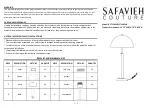
Tecnnical Data and Specifications
8-6
Revision 2 - 20 March, 1997
HP SERIES DIMMER
OPERATING MANUAL
Mains wiring colour codes
FLEX TAILS
INSTALLED WIRING
PHASE A
BROWN
RED
PHASE B
WHITE
WHITE
PHASE C
BLACK
BLUE
NEUTRAL
BLUE
BLACK
EARTH
GREEN / YELLOW
GREEN / YELLOW
8.5
Internal Mains Wiring
The HP dimmer has been designed to run from most commonly used power systems.
8.5.1
Normal Three Phase plus Neutral Operation
The HP12-TR and HP12-SC are normally supplied with a three-phase power cable
and plug attached, suiting the vast majority of available mains supplies (ie. three phase
and neutral).
The incoming mains supply must be protected at not more than 50 amps. The
dimmer’s circuit breakers are not rated to correctly clear faults if the supply protection
is in excess of this. Mains supplies are generally protected at lower currents (32 amps
or 40 amps at most Australian venues). It is the responsibility of the user to ensure that
the dimmer is used in a manner that does not exceed the available supply capacity.
The power cable is terminated within the dimmer at a six-way terminal block and an
earthing stud. The six-way terminal block has three poles for the three live mains
phases (labelled A1, A2, A3), and three poles for the mains neutral (N1, N2, N3). The
three neutral poles are bridged by a copper link, with the incoming mains neutral
connected to terminal A2.
8.5.2
Single Phase Operation
The dimmers may be configured for single phase operation where three phase mains
supply is unavailable.
The dimmer should be supplied with three same-phase actives and three neutrals. The
three active lines must each be protected at not more than 50 amps. The three neutral
conductors must each be rated at the same current as the actives. The earth conductor
should be similarly rated.
The bridge between the three neutral terminal poles (N1, N2, N3) must be removed
before the three incoming neutral lines are connected.
Although it is possible to supply the dimmer with one large single phase feed, the
dimmer’s breakers are not rated to clear faults if the supply is protected at currents of
over 50 amps.
The overvoltage detection will operate as normal. The voltage-difference detection
will sense whether the three supplies are present. The neutral-earth detection will act if
all three neutrals have more than 15 volts to earth, or if any one neutral has more than
45 volts to earth.


































